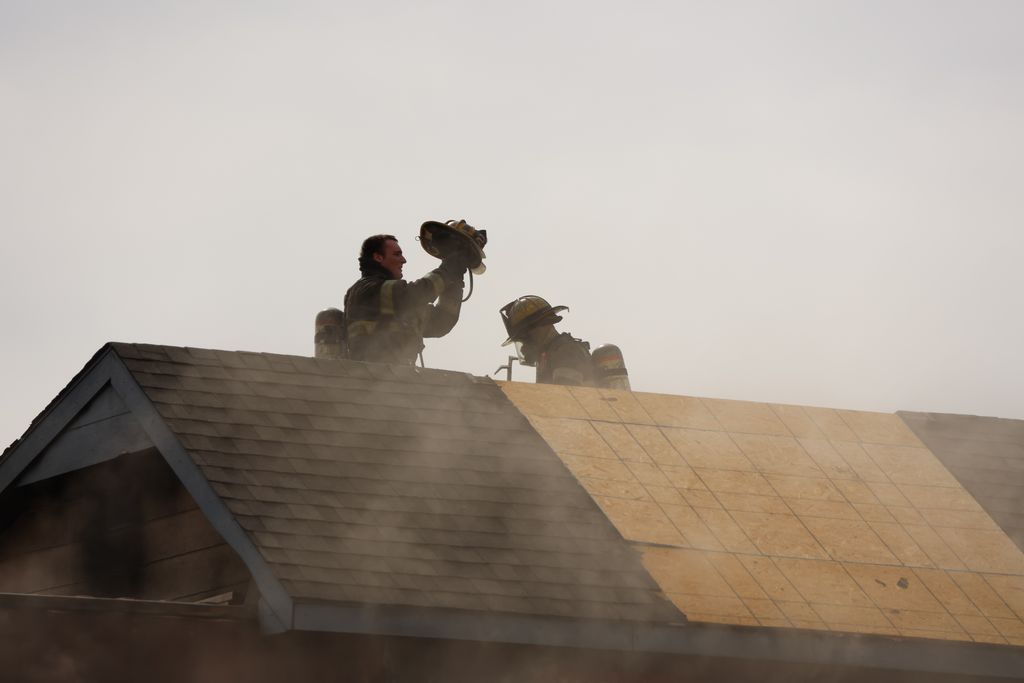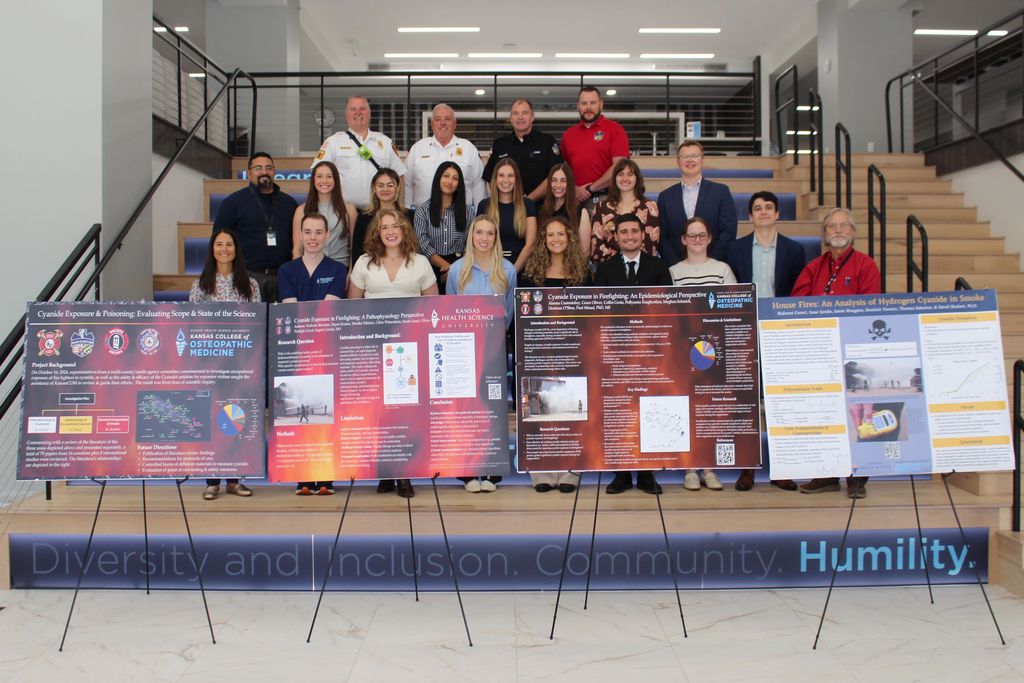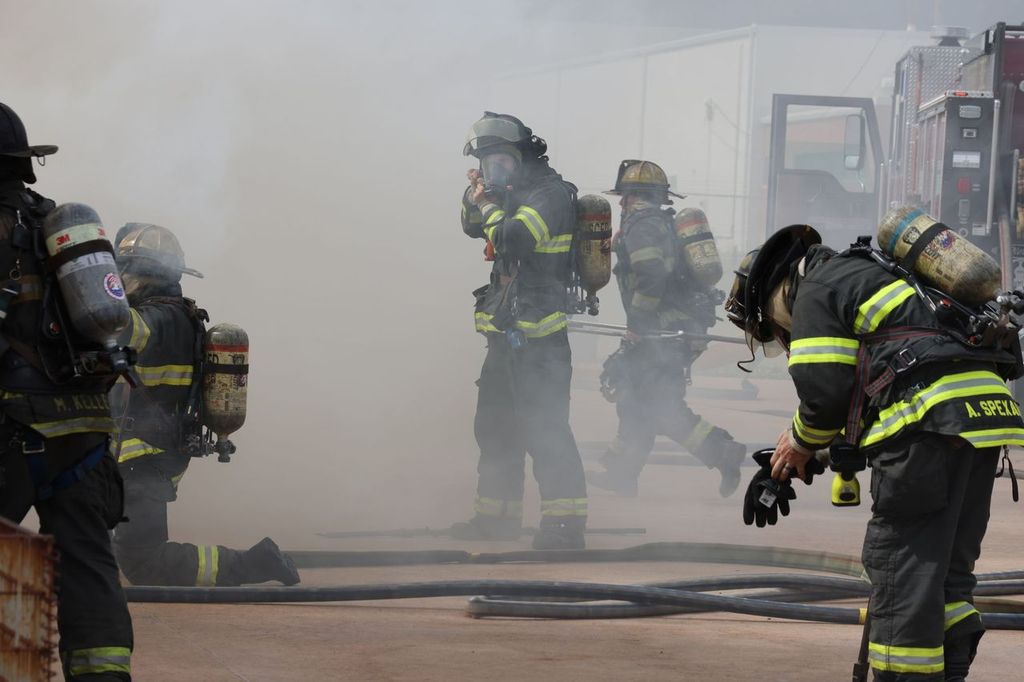Ray Hensley, deputy chief of operations for Sedgwick County Fire District 1, doesn’t mince words about the risks firefighters face when responding to structure fires. He stated that nearly 100 healthy firefighters die in the U.S. each year, most from heart attacks or strokes.
In a collaboration between Kansas Health Science University’s Kansas College of Osteopathic Medicine (KansasCOM) and local fire departments, student and faculty researchers aim to fill vital gaps in knowledge surrounding an invisible danger that exacerbates this cardiovascular strain: cyanide that’s released in smoke.
Rapidly absorbed through the lungs, cyanide can interfere with the body’s ability to use oxygen, potentially leading to difficulty breathing, nausea, and cardiac arrest.
Hensley says the research—focused on three key areas: the chemical makeup of smoke, occupational safety, and the effects and treatment of cyanide exposure—will help fire departments and emergency medical services (EMS) better understand who should receive the cyanide antidote (called a Cyanokit) and at what point in treatment. Before a Food and Drug Administration recall last year temporarily limited Cyanokit availability due to manufacturing issues, Sedgwick County Fire protocols recommended using Cyanokits only when victims were in full cardiac arrest and no longer breathing.
“We were utilizing Cyanokits on victims in full cardiac arrest, but would we be better served to use them on victims who are exhibiting early signs and symptoms of cyanide exposure?” Hensley asked. “Is it better to use Cyanokits on a smoke inhalation victim that’s still breathing?”
One of the faculty members heading the research, Paul Misasi, Ph.D., a former deputy director of Sedgwick County EMS, now serves as clinical faculty and assistant director of the Academic Center for Excellence at KansasCOM. He brings firsthand experience navigating the challenges of Cyanokit use, including its high cost, complex administration, infrequent use, unknown effectiveness, and short shelf life. These factors all play a part in how departments make treatment decisions.
“I think these projects are tremendous opportunities for us as a medical school and for our students to contribute to practical, action-based research and make a meaningful impact quickly,” Dr. Misasi says. “And it stands to reason that we could even inform better methods of point-of-care assessment to contribute to what firefighters do on a daily basis to keep them safe.”
Students Tackle Questions From All Sides
The three interdisciplinary research teams, each made up of first-year medical students from the Health Systems Science course and guided by a faculty mentor, are examining the cyanide exposure from different angles. Beginning with literature reviews, each group evaluated existing published research. Like pieces of a puzzle, their findings are coming together to form a clearer understanding of the risks posed by smoke inhalation.
For many students, the work feels personal. Jamie Maugans, a student doctor on the team studying smoke’s chemical composition, works as an EMT on an advanced life support ambulance during school breaks. Her team is investigating how variables such as airflow, temperature, and material type affect cyanide release.
Maugans says she was surprised to learn how much more cyanide modern, synthetic materials produce compared to traditional, natural ones.
“Things like mattresses, couch cushions, carpet, and even the glue in furniture all release more chemicals than organic wood,” she says. “Modern buildings are full of these composites and glues.”
Student doctor Allanna Cummiskey, part of the occupational safety team, is a former full-time paramedic and still works part-time during school breaks. Her team is focused on the health risks firefighters face on the job.
“It’s really nice to be able to try to help the population I’ve come to care about deeply,” she says. “There’s a decent amount of research into cyanide exposure in fire victims but not as much related to the actual firefighters who go in and put the fire out.”
Fire Departments Unite for Burn Demonstration
During a burn demonstration at the Wichita Fire Department Regional Training Center, firefighters from the Sedgwick County Fire Department, Wichita Fire Department, Derby Fire Department, Butler County EMS, and several volunteer departments showed the researchers how they interact with smoke during a fire response. They demonstrated how close they often get to the source, the equipment they use, and the real-time safety protocols they follow.
Cummiskey noticed that some firefighters, such as pump operators, weren’t wearing self-contained breathing apparatus (SCBAs) but were surrounded by smoke as the wind carried it from the engulfed structure.
Hensley explained that what the researchers witnessed was typical and there are good reasons why some firefighters wear air packs while others do not. He says there are policies in place for all firefighters who will potentially be exposed to products of combustion but there are other factors to consider.
“You can’t see everything you need to when you are wearing that mask,” Hensley says. “The guys who go up and do ventilation on the roof don’t wear masks because they want to see everything. Smell, hear, feel, touch, and taste everything they can to identify any issues before stepping on that roof. They’re protecting themselves by being observant.”

After the burns, Cummiskey’s and Dr. Misasi’s team used pulse oximeters and carbon monoxide (CO) detectors to check oxygen saturation and CO levels in firefighters, gathering early insights into how fire exposure affects vital signs. Dr. Misasi says there’s more potential in this kind of real-time data collection.
“When firefighters enter rehab, they check vital signs, they get an idea of what a person’s recovery status is, hydration, et cetera, and then they just turn them loose. None of that data goes anywhere,” Dr. Misasi says. “We want to lean on rehab units to start collecting data about firefighters that are actively working a fire and see if we can start to nail down where the real dangers exist.”
They are exploring if biomarkers such as lactate or carbon monoxide are effective as proxies for cyanide exposure.
From Research to Real-World Impact
As these students advance in their medical education, their projects will continue, laying the groundwork for safer practices in the field. For example, Maugans and her team plan to conduct controlled burns using synthetic materials to collect live samples and measure cyanide levels, collaborating with Wichita State University for laboratory analysis.
Each group will aim to submit their findings to a conference for presentation, a first publication for many. With further development, their work could lead to peer-reviewed journal articles and add to collective knowledge.
In the end, this partnership between KansasCOM and Kansas fire departments is sparking new ways to protect those who protect others, driven by tomorrow’s osteopathic physicians who are dedicated to innovation, research, and service.


